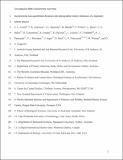Incorporating non-equilibrium dynamics into demographic history inferences of a migratory marine species
Abstract
Understanding how dispersal and gene flow link geographically separated populations over evolutionary history is challenging, particularly in migratory marine species. In southern right whales (SRWs, Eubalaena australis), patterns of genetic diversity are likely influenced by the glacial climate cycle and recent history of whaling. Here we use a dataset of mitochondrial DNA (mtDNA) sequences (n=1,327) and nuclear markers (17 microsatellite loci, n=222) from major wintering grounds to investigate circumpolar population structure, historical demography, and effective population size. Analyses of nuclear genetic variation identify two population clusters that correspond to the South Atlantic and Indo-Pacific ocean basins that have similar effective breeder estimates. In contrast, all wintering grounds show significant differentiation for mtDNA, but no sex-biased dispersal was detected using the microsatellite genotypes. An approximate Bayesian computation (ABC) approach with microsatellite markers compared scenarios with gene flow through time, or isolation and secondary contact between ocean basins, while modeling declines in abundance linked to whaling. Secondary-contact scenarios yield the highest posterior probabilities, implying that populations in different ocean basins were largely isolated and came into secondary contact within the last 25,000 years, but the role of whaling in changes in genetic diversity and gene flow over recent generations could not be resolved. We hypothesis that these findings are driven by factors that promote isolation, such as female philopatry, and factors that could promote dispersal, such oceanographic changes. These findings highlight the application of ABC approaches to infer connectivity in mobile species with complex population histories and currently low levels of differentiation.
Citation
Carroll , E L , Alderman , R , Bannister , J L , Bérube , M , Best , P B , Boren , L , Baker , C S , Constantine , R , Findlay , K , Harcourt , R , Lemaire , L , Palsbøll , P J , Patenaude , N J , Rowntree , V J , Seger , J , Steel , D , Valenzuela , L O , Watson , M & Gaggiotti , O E 2019 , ' Incorporating non-equilibrium dynamics into demographic history inferences of a migratory marine species ' , Heredity , vol. 122 , no. 1 , pp. 53-68 . https://doi.org/10.1038/s41437-018-0077-y
Publication
Heredity
Status
Peer reviewed
ISSN
0018-067XType
Journal article
Description
ELC was supported while writing this paper by a EU Horizon 2020 Marie Slodowska Curie Fellowship, project BEHAVIOUR-CONNECT, by a Newton Fellowship from the Royal Society of London and Bayesian statistical training was supported by National Science Foundation (award DEB- 1145200). Laboratory analyses conducted by ELC were funded by a small grant from the British Ecological Society 5076 / 6118 and Bayesian analysis was supported by training from the National Science Foundation under Grant No. DEB-1145200. OEG was supported by the Marine Alliance for Science and Technology for Scotland (MASTS) funded by the Scottish Founding Council (grant reference HR09011). Genetic data from the South African right whale samples were generated by MB and PJP with the support of UC Berkeley, University of Stockholm and University of Groningen. Computational Biology analyses were supported by the University of St Andrews Bioinformatics Unit which is funded by a Wellcome Trust ISSF award.Collections
Items in the St Andrews Research Repository are protected by copyright, with all rights reserved, unless otherwise indicated.

